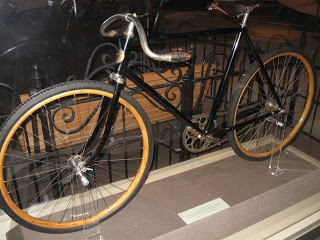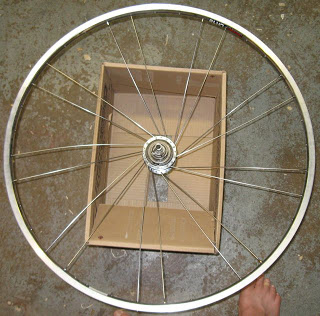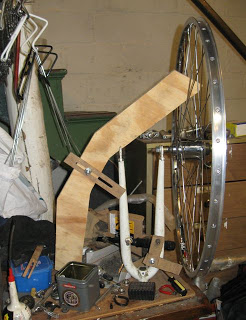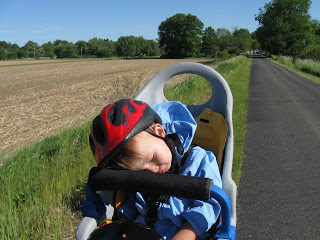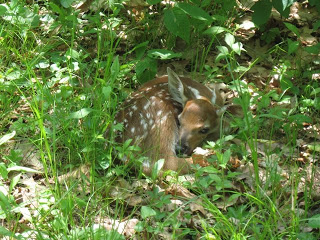On Sunday, five friends and I made our most ambitious attempt yet at the Tour des Sharps. This long bike ride visits all four Sharp Edge locations before returning home. Of course, you can’t stop at Sharp Edge without having a beer, so it’s a bit of an epic “pub crawl.” We planned the ride for Father’s day: the longest day of the year, and a good day for us all to get the “day off.”
Disclaimer: despite any appearances, this wasn’t a group ride, and I didn’t organize it. Because I don’t organize events when I’m not being paid, and I don’t go on group rides.
Our plan was to leave in time to reach the Peters Township location when it opened: noon, so we couldn’t really start before 10am. From there, the route would take us to the Creek House in Crafton, the Bistro in Sewickley, and the Beer Emporium in Friendship. We’d meet all our families in Friendship, have dinner, and then make the short 5 mile ride home. Our route planning on bikely.com suggested it would be around 65 miles. There should be plenty of time to fit that in daylight hours, along with a few meals and beers. Right?
The first wrench in our works came in the form of a scheduling conflict: YAPC scheduled its arrival dinner for the exact time and location of our last planned stop: Sharp Edge beer emporium, at 6pm. Although me and one other rider were attending this conference, neither of us wanted to attend the arrival dinner. And, they booked the entire back dining room, which wouldn’t leave enough room for our party of 15 in the front. So, we reluctantly made alternate plans which didn’t include the Friendship Sharp Edge location.
The rest of our wrenches came in the form of Reality, which has a tendency to foil best-laid plans (let alone the rest of them).
We met and finally left at about 10:30am from Regent Square. The first leg of about 22 miles to the Peters Township location was not that difficult, but it did include a few long, if not steep, climbs. That’s pretty much par for the course in Pittsburgh, though.
Mom can skip this paragraph: Close to our first destination on a corner into a parking lot, I hit a patch of gravel, slid and fell down. Luckily I had gloves on, and wasn’t going very fast: it could’ve been much worse. I bumped my left shoulder, hip, leg, and hand, and somehow scratched my right arm, but there was no blood. I had to tweak my rear fender back into position, but there was otherwise no damage to my bike. It made the impending stop very timely.
I had a Grimbergen, a somewhat lower alcohol content Belgian beer (6.5%) because they were out of De Koninck on tap (closer to 5%). When I’m at the Sharp Edge, I usually only get Belgian beers on tap, since none of the locations have fewer than 20 different Belgian varieties on tap. I always remember liking Grimbergen, but unfortuantely I forget that when I actually taste it, it’s a lot plainer and less complex than I expect. It has a very clean, unsurprising taste, which is not often what I’m looking for.
This stop signalled an unfortunate trend for the day: although the bar had almost no customers, it was excruciatingly slow because they had no incentive to kick us out of our seats. It took far too long to be served and settle our bill.
The next leg to Crafton was shorter, maybe 13-15 miles? The pace of all riders was fairly well matched, but one of us was riding a single speed. With one gear they could keep pace on the hills, but “spun out” on the flats and couldn’t keep up with the geared riders… not that there were many flats anyway. None of our riding so far was particularly scenic: it was mostly suburban. I quickly decided I prefer urban riding over suburban, though rural is even better. We hoped to get some back road riding in when we left Sewickley up into the hills.
At the creek house, I had a De Koninck. My experience with this beer is the opposite of how I feel about Grimbergen: it is always better than I expect it to be. I’m not sure what gave me my long-standing idea that I don’t like it very much. Soon we noticed it was 4pm: this is when we expected to arrive at Sewickley, but we were far behind schedule. I called Marla and we tentatively rescheduled our family dinner, though it was seeming like we might not make it before the kids’ bedtime at all.
After a seemingly interminable wait we left for Sewickley, another 13-15 miles. But Wait: does anyone know the address? No? I thought you had it. A call to Marla and a GPS consultation got us back on the right track.
The day had really warmed up on the last leg, and this slowed us down a lot. We hit some long but not horribly steep hills, and the group really started to stretch out: some riders were starting to run out of steam.
We got to Sewickley at the 50 mile mark. None of us had been to this location before. Unfortunately, this hoity-toity “bistro” met all of my expectations: they really didn’t want a group of smelly cyclists in there. Having been to 2 other Sharp Edge locations that day made it really obvious that the prices for identical items were higher, the menu was smaller, and the beer selection more limited. The space was cleaner, but lacked the character of the older locations in Crafton and Friendship. We were all unimpressed by the bartenders/servers, and overall I wasn’t that interested in returning.
It was already almost 6pm. One of us decided to bail and call for a sag wagon, and the rest of us thought it would be best to eat dinner here. So, we cancelled the family dinner plans, and decided we’d tentatively stop at the Friendship location on the way home, since we could probably fit 5 of us at the bar even with the crowds.
Since I was also having food, I splurged and had a Karmeliet Triple, which I always really enjoy. It’s fairly sweet, but has a nice complex flavor. After that I tried Zotten, a “Belgian style pale ale” by Weyerbacher in Easton PA, and on tap exclusively at Sharp Edge. It was fairly good for an Amerian craft brewed Belgian style beer, but it’d be hard to mistake it for a true Belgian. It was sweet, but had “too much high end.” (I tend to use sound-related terms to describe the flavors or spices in food and drink: in my mind a good audio mix is comparable to well balanced flavors in a dish or beer. Sometimes I wonder if this is what synaesthesia feels like?)
By the time the remaining 5 riders set off, it was already a bit after 7pm! It was almost 9 hours since we started, and according to our plans we still had over 20 miles of riding and one more stop.
At this point, we started cutting corners. We decided to go back across the river and take Rt 51 back to town, instead of finding our way through Sewickley’s hills to the North. None of us were familiar with the back roads, and we weren’t that interested in getting lost up there with limited daylight left.
We could’ve gone across Neville Island for a flatter, straighter route home, but it was only after we failed to do this that we remembered 51 didn’t stay next to the river. More hills! We all managed to get up the hills in a fairly close group: we were keeping a good pace. What goes up must come down, so we had some really excellent descents. On one hill my GPS caught a maximum speed of 42mph as we pulled away from the cars which were following us. That record was soon bested by 43.8mph on a subsequent hill. If I were more familiar with the roads I would’ve known I didn’t need to brake for those curves, but unfortuantely that hindsight will likely go wasted.
The next corner to be cut was any illusion of making another stop. Even without a stop, we’d be pushing the limits of daylight, and the fathers in the group thought it prudent to try to see their kids before bedtime. So we took the most direct route back to our starting poing. When we got close to town, we entered the Station Square parking lot, met up with the South Side trail (smooth, flat) and headed towards South Side Works. Two of the riders left there, sore and badly in need of beer, after 66.7 miles of riding.
The rest of the ride was easy: basically my daily commute home. The last two riders other than me got to Regent Square at 73 miles, and I made it home at 74.4 miles and almost exactly 9pm.
According to my GPS, our meaningless numbers for this trip were:
- 74.4 miles travelled, my second highest mileage day ever
- 5823 ft of elevation gain
- moving time of 6:02 hours
- average moving speed of 12.3mph
- max speed 43.8mph (maybe that’s the part Mom shouldn’t read?)
Overall, I have mixed feelings, and a few lessons learned.
Make no mistake: I really enjoyed the ride!
But it didn’t go according to plan, and it’s unfortunate we couldn’t all finish. I’m glad we had no mechanical problems, and that we all ended up riding well together though we hadn’t all ridden with each other before.
We were out for ten and a half hours, but my GPS said we were only riding for 6. I planned for our 6 hour riding time, but for only 2 hours of stops before reaching the family dinner. What the heck? Since we didn’t originally plan to eat at Sewickley, it only would’ve taken about an hour less waiting to get to the family dinner on time and complete the trip as planned.
A lesson learned: Sunday is Slow Day. The roads are empty, traffic is wonderful, and you’ll get a table with no waiting at almost any place you care to go. But since no one is in line behind you, and since they don’t pay high-end staff for low-end days, you wait. A lot.
For me, this was about a week’s worth of riding in a day. But we got a lot more than an average week’s worth of jerky drivers on the trip, especially considering the low traffic density. I expect it’s because there were 6 of us. The most common exclamation heard from seemingly friendly people is “Lance!” so I’m sure the jerks also found us indistinguishable from the average pack of racer-wannabes, despite the motley, unconventional appearance any “roadie” would see from a mile away.
The only other minor complaint I have for the Tour des Sharps in general, is that the most direct routes possible are also pretty bad. They mostly stay in the suburbs, riding on what would ordinarily be busy commercial streets. If I could choose any 75 mile loop starting from my house, this route would definitely not be it.
A day after the ride, I basically don’t feel any soreness as long as I’m sitting still, and I had no problem riding to and from YAPC today. It’s only when I try to be active that my muscles quietly say “please don’t do that.”
At this point, I’m still interested in doing at least one or two more 60-100 mile rides this year. However, it’ll probably be at least next year before another Tour des Sharps is in the cards. Beer and cycling are both very enjoyable, but I think I enjoy them more separately rather than simultaneously.
